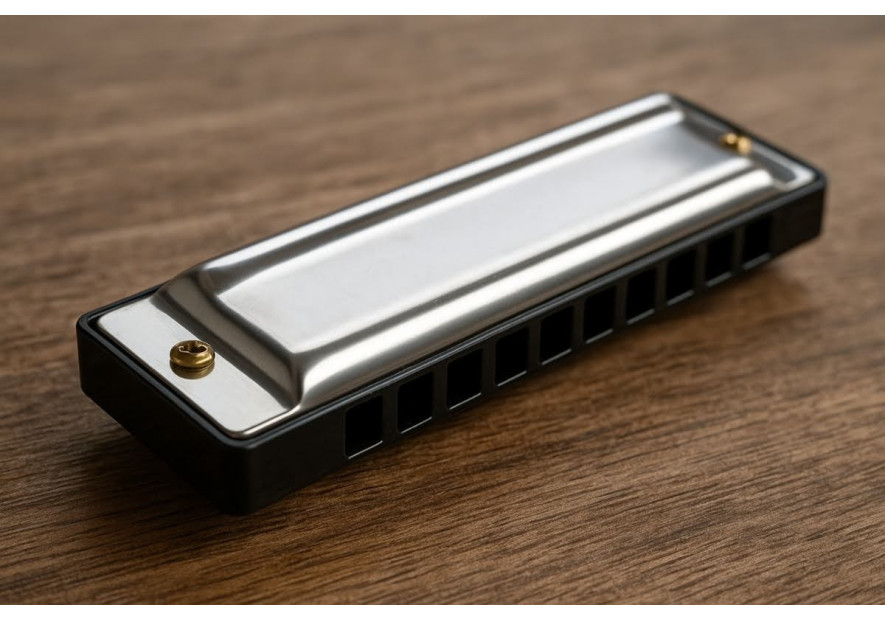10 Common Harmonica Mistakes Beginners Make

Starting on the harmonica can feel like trying to whistle with a mouthful of marbles. It’s deceptively small, yet packed with nuance—and while its learning curve is far from vertical, it does come with a few traps that trip up almost every newcomer.
From awkward breathing habits to using the wrong gear, common harmonica mistakes can slow down your progress more than you think.
But here’s the good news: most of them are fixable. Many players improve overnight just by tweaking a few core habits.
Let’s break down ten of the usual suspects—and how to leave them behind for good.
1. Playing Too Hard (Seriously, Take It Easy)
New players often think they need to blow like they’re trying to knock dust out of an attic. In reality, harmonicas respond best to gentle, steady airflow.
Blowing too hard doesn't just wear you out—it throws off your tone, causes notes to squeak or stall, and can permanently damage the reeds, especially in lower-quality models.
Choose one of the beginner-friendly models and start light. If your notes aren’t responding, it’s more likely a technique issue than a lack of force. Think finesse over force. It’s not a brass instrument—it’s closer to humming than huffing.
2. Ignoring Breathing Technique
Here’s the thing: your lungs are your engine. If you’re breathing shallowly from your chest instead of deep from your diaphragm, you’re setting yourself up for limited airflow, tension, and inconsistent tone.
Breathing control is one of the key harmonica techniques beginners need to master. It might feel challenging at first, but once you start playing longer phrases—or performing live—it catches up fast.

Try this: lie on your back with a book on your belly. Breathe so the book rises and falls, not your chest. That’s diaphragmatic breathing. Do that when you play, and everything gets easier.
3. Skipping the Basics and Jumping to Bending
Bending is like the holy grail of blues harmonica—soulful, expressive, and unmistakably cool. But beginners often obsess over it too early, before mastering clean single notes. That’s like trying to skateboard before you’ve learned to stand up.
Get your foundations rock-solid first. Focus on control, accuracy, and tone. Learn where each note lives. Bending will come faster and cleaner if you put in the work upfront.
4. Not Using Tongue Blocking (Or Overusing It)
Technique-wise, this is where things get a little... philosophical. Some swear by tongue blocking. Others prefer puckering. The truth? You need both.
Tongue blocking gives you access to cool effects like slaps, pulls, and octaves. But if that’s all you use, your phrasing might become stiff.
Likewise, if you avoid it altogether, you’re leaving expressive tools on the table. Learn both. Switch when the music calls for it. It’s not about loyalty—it’s about flexibility.
5. Poor Hand Position
Your hands are more than holders—they’re tone shapers. A cupped hand creates resonance, warmth, and that classic “wah-wah” effect when moved. But if your hands are too tight, you choke the sound. Too loose? You lose projection and clarity.
The sweet spot is a relaxed, curved shape that allows for both resonance and expression. Watch videos of players like Sonny Boy Williamson or Jason Ricci and study their grip—it’s subtle, but it matters more than you think.
6. Practicing Without Listening
This one’s sneaky. You might spend hours playing every day, but if you’re not listening to yourself or others, you’re flying blind. Many beginners repeat patterns without noticing off-pitch bends, sloppy timing, or breathy tone.
Eventually, these habits hardwire themselves in.
Record yourself, even on your phone. Listen back with a critical but kind ear. Compare your tone with players you admire. Ask: Is this clean? Is this expressive? Mindful practice will always beat mechanical repetition.
7. Using the Wrong Harmonica
This one’s surprisingly common. Many beginners grab whatever harmonica is cheapest or lying around, not realizing they might be fighting the instrument itself.
Remember, there are many different types of harmonica, each with its own strengths and quirks. It’s worth doing a little research and asking around to find the model that suits you best. Cheap harps often leak air, go out of tune fast, or feel stiff and unresponsive.
Equally problematic? Playing the wrong key. Most tutorials and tabs use a C harmonica—so if you’re playing an A or G, nothing will match up.
Invest in a quality 10-hole diatonic harp in the key of C. It’ll sound better, respond smoother, and make learning far less frustrating.

Diatonic harmonicas, by the way, are generally better suited for beginners. We recommend progressing to chromatic models only after you’ve mastered the basics and gained some experience under your belt.
8. Neglecting Rhythm
You can hit all the right notes—but if your timing’s off, it’ll still sound off. Rhythm is the glue that holds everything together. And yet, many beginners practice isolated riffs or scales without any beat to anchor them.
Use a metronome or drum track, even at slow tempos. Practice clapping rhythms before playing them. Try playing along with simple blues backing tracks to internalize the groove. It’s not just about staying on time—it’s about feeling the time.
9. Thinking It’s All About the Notes
Technically perfect playing doesn’t always move people. A single, well-placed, emotional note can hit harder than a flurry of flashy ones. The harmonica is incredibly expressive—don’t reduce it to just pitch and timing.
Explore tone variations. Add vibrato. Use dynamics—soft, loud, sudden pauses. Let silence breathe. Music is communication, and feeling often trumps precision. The sooner you learn that, the more impact your playing will have.
10. Learning in Isolation
No one learns music in a vacuum—not for long, anyway. If you’re stuck in solo YouTube sessions or practicing silently in your room, you’re missing out on feedback, motivation, and creative spark.
Join a local jam. Post clips online. Ask questions in harmonica forums. Watch how others solve problems or express ideas. Engaging with the community doesn’t just help you learn faster—it reminds you why you picked up the harmonica in the first place.
Wrap It Up: Start Right, Stay Inspired
Here’s the truth: almost every beginner stumbles. That’s part of the process.
But the players who improve quickly are the ones who spot their blind spots and keep showing up with curiosity. By recognizing these common harmonica mistakes, you’ll give yourself an edge—and more importantly, you’ll make playing way more fun.
If you're serious about learning—and you want gear that grows with you—HARMO offers a range of beginner harmonica models designed to help you master the basics while preparing you for more advanced playing.
Thoughtfully crafted, easy to play, and designed to inspire, these harmonicas don’t just sound good… they feel good in your hands.
Contact us today, and we’ll help you pick out a harmonica that fits your style and experience level.



Leave a comment